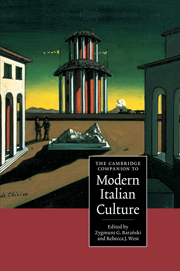Book contents
- Frontmatter
- Introducing modern Italian culture
- 1 The notion of Italy
- 2 Social and political cultures in Italy from 1860 to the present day
- 3 Questions of language
- 4 Intellectuals, culture and power in modern Italy
- 5 Catholicism
- 6 Socialism, Communism and other ‘isms’
- 7 Other voices: contesting the status quo
- 8 Narratives of self and society
- 9 Searching for new languages: modern Italian poetry
- 10 Drama: realism, identity and reality on stage
- 11 Italian cinema
- 12 Art in modern Italy: from the Macchiaioli to the Transavanguardia
- 13 A modern identity for a new nation: design in Italy since 1860
- 14 Fashion: narration and nation
- 15 The media
- 16 Since Verdi: Italian serious music 1860-1995
- 17 Folk music and popular song from the nineteenth century to the 1990s
- 18 Epilogue: Italian culture or multiculture in the new millennium?
- Index
- Series List
9 - Searching for new languages: modern Italian poetry
Published online by Cambridge University Press: 28 May 2006
- Frontmatter
- Introducing modern Italian culture
- 1 The notion of Italy
- 2 Social and political cultures in Italy from 1860 to the present day
- 3 Questions of language
- 4 Intellectuals, culture and power in modern Italy
- 5 Catholicism
- 6 Socialism, Communism and other ‘isms’
- 7 Other voices: contesting the status quo
- 8 Narratives of self and society
- 9 Searching for new languages: modern Italian poetry
- 10 Drama: realism, identity and reality on stage
- 11 Italian cinema
- 12 Art in modern Italy: from the Macchiaioli to the Transavanguardia
- 13 A modern identity for a new nation: design in Italy since 1860
- 14 Fashion: narration and nation
- 15 The media
- 16 Since Verdi: Italian serious music 1860-1995
- 17 Folk music and popular song from the nineteenth century to the 1990s
- 18 Epilogue: Italian culture or multiculture in the new millennium?
- Index
- Series List
Summary
Tradition: stimulus or millstone?
In newly unified Italy, the Italian literary tradition was particularly venerated. The period's leading poet, Giosue Carducci (1835-1907), in the vigorously anti-Romantic preface to his Rime ('Poems') of 1857,had identified only three poetic currents as worthy of cultivation in an 'Italian Italy': Classical Latin; the medieval and Renaissance tradition from Dante to Tasso; and the neo-Classical current from Alfieri to Leopardi. Carducci wrote academic studies on Dante, Petrarch and Leopardi, and echoed Dante's civic poetry in his invectives against those of his own contemporaries who seemed unworthy of their country's past. Both as a passionate Republican and democrat before 1871, and subsequently as a Monarchist, Carducci saw poetry as an elevated civic calling: the 'Congedo' ('Envoy') to the Rime nuove ('New Poems', 1887) famously pictures the poet as a blacksmith who, in his fiery soul, fashions glorious national memories into swords to fight for freedom, shields for protection, and garlands to celebrate victory. Thus, to inspire his contemporaries, Carducci’s public poetry draws on episodes from Italy’s history, often linking them into an ideal narrative culminating in unification. He celebrates Italy’s Roman heritage, the triumphs of its free medieval communes, its famous poets and, especially, the heroes of unification. Even his metrics illustrate his belief that the past could nourish the present: his Odi barbare (‘Barbarian Odes’) aim at the effect of classical Latin verse forms, as read during the ‘barbarian’ period when distinctions between vowel lengths were lost and rhythms were based instead on tonic stress.
- Type
- Chapter
- Information
- The Cambridge Companion to Modern Italian Culture , pp. 173 - 196Publisher: Cambridge University PressPrint publication year: 2001

